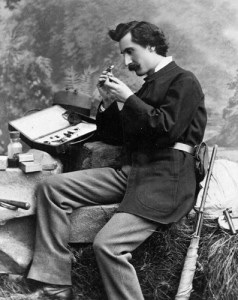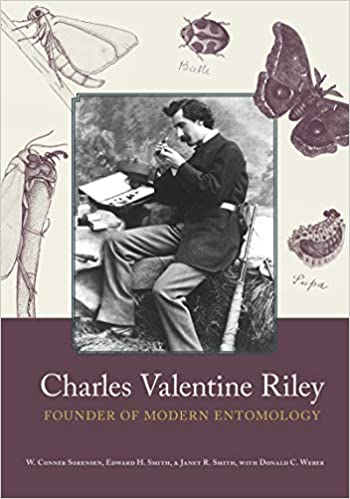The Life & Legacy of Charles Valentine Riley
"... None but the well-informed are successful…for success in agriculture today implies knowledge — scientific knowledge."
—Charles Valentine Riley (1872)

A vision for the success of agriculture
A vital and colorful personality, Charles Valentine Riley was a major 19th century figure who possessed a vision for enhancing the success of agriculture through new scientific knowledge. Born in London in 1843, Riley at the age of 17 immigrated to the United States, where he began work as a farm laborer, writer and illustrator in upstate Illinois.
State and national leadership
Riley was named Missouri’s first State Entomologist in 1868, the Chief of the U.S. Entomological Commission in 1876 and the Chief Entomologist for the U.S. Department of Agriculture in 1878. He was responsible for one of the first outstanding successes in the biological control of pests by introducing the Australian vedalia beetle to combat scale insects. He also was a key figure in research that led to the rescue of the French wine industry from an insect pest.
Ongoing impact
The impact of Riley’s work 150 years ago is still felt today, not only in the fields of entomology and agriculture but also in other natural sciences. Riley was the first to recommend the establishment of the Office of Experiment Stations. He advocated establishment of the Branch of Economic Ornithology within USDA, which evolved into the Biological Resources Division of the U.S. Geological Survey that is now in the U.S. Department of Interior.
"Whole picture"
Riley truly was a “whole-picture” person — an artist, poet, writer, journalist, linguist, naturalist and philosopher, as well as a scientist and administrator. In 1878, Riley joined with Alexander Graham Bell, John Wesley Powell and 57 other men in science, literature and the arts to found the Cosmos Club in Washington, D.C., as a “social club for individuals of distinction and sociability.”
Sustaining Riley's memory
Riley initiated the National Collection of Insects at the Smithsonian Museum of Natural History and was honorary curator of the collection when he died of injuries from an accident in 1895. Upon the death in 1978 of Riley’s last surviving child, Dr. Cathryn Vedalia Riley, a trust was established to further Riley’s memory. This trust assisted in the founding of the Charles Valentine Riley Memorial Foundation. Thus, the singular characteristic of Riley as a “whole-picture” person is reflected in the precepts and goals of the Riley Memorial Foundation. Perhaps Riley’s greatest legacy was his vision and ability to see the role of agriculture and forestry in the productive and sustainable use of the landscape as an artistry upon which all society depends.
Learn more about Charles Valentine Riley
The USDA National Agricultural Library’s Special Collections includes a Charles Valentine Riley Collection that illustrates Riley’s vision to enhance the success of agriculture through new scientific knowledge. The collection of papers and significant artifacts also tells the story of Riley’s love of nature, his keen ability to observe relationships in nature and his devotion to recording his observations through drawing and writing. The Riley collection complements a number of other significant manuscripts and rare books in Special Collections, providing historians and researchers a broad picture of the field of entomology in the 1800s.
In 1996, the American Entomologist published a paper on the legacy of Riley that reflects on his contributions at the centennial (1995) of his death. “Charles Valentine Riley: The Making of the Man and His Achievements, by Edward H. Smith and Janet R. Smith” notes that Riley (1843–1895) ranks as one of the distinguished founders of entomology in North America.
Charles Valentine Riley: Founder of Modern Entomology
Charles Valentine Riley: Founder of Modern Entomology by W. Conner Sorensen (Author), Edward H. Smith Ph.D. (Author), Janet R. Smith (Author), Donald C. Weber (Contributor)

This definitive biography is the first full account of a fascinating American scientist whose leadership created the modern science of entomology that recognizes both the essential role of insects in natural systems and their challenge to the agricultural food supply that sustains humankind. Charles Valentine Riley: Founder of Modern Entomology tells the story of how Riley (1843–1895), a young British immigrant to America—with classical schooling, only a smattering of natural history knowledge, and with talent in art and writing but no formal training in science—came to play a key role in the reorientation of entomology from the collection and arrangement of specimens to a scientific approach to insect evolution, diversity, ecology, and applied management of insect pests.
Drawing on Riley’s personal diaries, family records, correspondence, and publications, the authors trace Riley’s career as farm laborer, Chicago journalist, Missouri State Entomologist, chief federal entomologist, founder of the National Insect Collection, and initiator of the professional organization that became the Entomological Society of America. Also examined in detail are his spectacular campaigns against the Rocky Mountain Locust that stalled western migration in the 1870s, the Grape Phylloxera that threatened French vineyards in the 1870s and 80s, the Cotton Worm that devastated southern cotton fields after the Civil War, and the Cottony Cushion Scale that threatened the California citrus industry in the 1880s. The latter was defeated through importation of the Vedalia Beetle from Australia, the spectacular first example of biological control of an invasive insect pest by its introduced natural enemy.
A striking figure in appearance and deed, Riley combined scientific, literary, artistic, and managerial skills that enabled him to influence every aspect of entomology. A correspondent of Darwin and one of his most vocal American advocates, he discovered the famous example of mimicry of the Monarch butterfly by the Viceroy, and described the intricate coevolution of yucca moths and yuccas, a complex system that fascinates evolutionary scientists to this day. Whether applying evolutionary theory to pest control, promoting an American silk industry, developing improved spray technologies, or promoting applied entomology in state and federal government and to the public, Riley was the central figure in the formative years of the entomology profession. In addition to showcasing his own renderings of the insects he investigated, this comprehensive account provides fresh insight into the personal and public life of an ingenious, colorful, and controversial scientist, who aimed to discover, understand, and outsmart the insects.
ISBN-13: 978-0817320096
ISBN-10: 0817320091